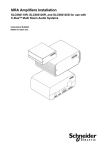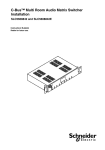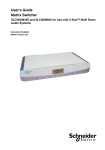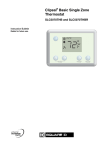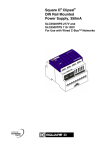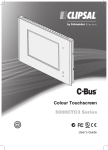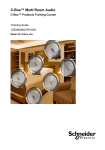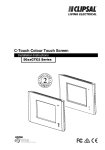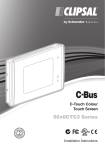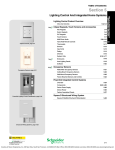Download Schneider Electric SLC560110R User`s guide
Transcript
User's Guide Multi Room Audio Amplifiers SLC560125D, SLC560125R and SLC560110R for Use with Wired C-Bus™ Networks Instruction Bulletin Retain for future use. Multi Room Audio Amplifiers User's Guide 63249-420-267A2 06/2010 HAZARD CATEGORIES AND SPECIAL SYMBOLS Read these instructions carefully and look at the equipment to become familiar with the device before trying to install, operate, service, or maintain it. The following special messages may appear throughout this bulletin or on the equipment to warn of potential hazards or to call attention to information that clarifies or simplifies a procedure. The addition of either symbol to a “Danger” or “Warning” safety label indicates that an electrical hazard exists which will result in personal injury if the instructions are not followed. This is the safety alert symbol. It is used to alert you to potential personal injury hazards. Obey all safety messages that follow this symbol to avoid possible injury or death. Danger indicates an immediately hazardous situation which, if not avoided, will result in death or serious injury. Warning indicates a potentially hazardous situation which, if not avoided, can result in death or serious injury. Caution indicates a potentially hazardous situation which, if not avoided, can result in minor or moderate injury. Caution, used without the safety alert symbol, indicates a potentially hazardous situation which, if not avoided, can result in property damage or improper operation. NOTE: Provides additional information to clarify or simplify a procedure. 2 © 2010 Schneider Electric. All Rights Reserved. 63249-420-267A2 06/2010 Multi Room Audio Amplifiers User's Guide PLEASE NOTE Electrical equipment should be installed, operated, serviced, and maintained only by qualified personnel. This document is not intended as an instruction manual for untrained persons. No responsibility is assumed by Schneider Electric for any consequences arising out of the use of this manual. FCC CLASS B This device complies with Part 15 of the FCC Rules. Operation is subject to the following two conditions: (1) this device may not cause harmful interference, and (2) this device must accept any interference received, including interference that may cause undesired operation. This equipment has been tested and found to comply with the limits for a Class B digital device, pursuant to Part 15 of the FCC Rules. These limits are designed to provide reasonable protection against harmful interference in a residential installation. This equipment generates, uses, and can radiate radio frequency energy and, if not installed and used in accordance with the instructions, may cause harmful interference to radio communications. However, there is no guarantee that interference will not occur in a particular installation. If this equipment does cause harmful interference to radio or television reception, which can be determined by turning the equipment off and on, the user is encouraged to try to correct the interference by one or more of the following measures: Reorient or relocate the receiving antenna. Increase the separation between the equipment and receiver. Connect the equipment into an outlet on a circuit different from that to which the receiver is connected. Consult the dealer or an experienced radio/TV technician for help. Changes or modifications to this device that are not expressly approved by Schneider Electric could void the user's authority to operate this equipment. © 2010 Schneider Electric. All Rights Reserved. 3 Multi Room Audio Amplifiers User's Guide 63249-420-267A2 06/2010 PRODUCT LABEL Refer to the warning label appearing on the product illustrated below. Refer to the "Notices" section at the beginning of this bulletin for definitions of the symbols appearing on the label. Carefully read and follow the safety precautions both on the equipment and contained in this bulletin before attempting to install or maintain electrical equipment. IMPORTANT SAFETY INSTRUCTIONS The appliance coupler shall remain readily operable once the product is installed. 1. Read these instructions. 2. Keep these instructions. 3. Heed all warnings. 4. Follow all instructions. 5. Do not use this apparatus near water. 6. Clean only with dry cloth. 7. Do not block any ventilation openings. Install in accordance with the manufacturer’s instructions. 8. Do not install near any heat sources such as radiators, heat registers, stoves, or other apparatus (including amplifiers) that product heat. 9. Do not defeat the purpose of the polarized or grounding-type plug. A polarized plug has two blades with one wider that the other. A grounding type plug has two blades and a third grounding prong. The wide blade or the third prong are provided for your safety. If the provided plug does not fit into your outlet, consult an electrician for replacement of the obsolete outlet. 10. Protect the power cord from being walked on or pinched particularly at plugs, convenience receptacles, and the point where the exit from the apparatus. 11. Only use the attachments/accessories specified by the manufacturer. 12. When a cart is used, use caution when moving the cart/apparatus combination to avoid injury from tip-over. 13. Unplug this apparatus during lightning storms or when unused for long periods of time. 14. Refer all servicing to qualified service personnel. Servicing is required when the apparatus has been damaged in any way such as power supply cord or plug is damaged, liquid has been spilled or objects have fallen into the apparatus, the apparatus has been exposed to rain or moisture, does not operate normally, or has been dropped. 4 © 2010 Schneider Electric. All Rights Reserved. 63249-420-267A2 06/2010 Multi Room Audio Amplifiers User's Guide MULTI ROOM AUDIO AMPLIFIERS A Multi Room Audio (MRA) Amplifier is part of a C-Bus enabled audio distribution system. C-Bus input units control the amplifier. Examples of C-Bus input units that control MRA amplifiers include Saturn™ and Neo™ wall switches, DLT™ switches, and Color Touchscreens. The Multi Room Audio (MRA) Amplifiers distribute audio to an assigned zone within a home or office as part of the MRA System. Three types of MRA amplifiers are shown in the figure below. A MRA layout may contain any combination of these amplifiers. A single amplifier is a valid configuration, and several amplifiers can be used or linked together on a C-Bus network. Figure 1: Catalog Numbers - MRA Amplifiers KEY: A. SLC560110R Low Power Remote Amplifier B. SLC560125R Remote Amplifier C. SLC560125D Desktop Amplifier All types of MRA amplifiers have connections for line level stereo inputs, speakers and C-Bus. When several amplifiers are connected together, a digital audio cable distributes the audio program from amplifier to amplifier. For more details, refer to the C-Bus Multi Room Audio Amplifier Installation Instructions. © 2010 Schneider Electric. All Rights Reserved. 5 Multi Room Audio Amplifiers User's Guide 63249-420-267A2 06/2010 FEATURES AND CAPABILITIES MRA amplifiers can be used in a standalone configuration without an MRA Matrix Switcher. Using a standalone MRA amplifier: 6 A stereo input source from a CD player, PC sound card, MP3 player, or other line-level source is plugged in. Contact a C-Bus installer for a convenient stereo source input wall plate connection, if desired. Each amplifier in the installation is individually controlled using C-Bus. Controls include volume, tone, and muting the speakers. The Amplifier can be controlled through C-Bus input switches, a hand held remote control, and the Desktop Amplifier's manual front panel controls. The desktop model also has a power standby mode. Additional amplifiers can be added in other rooms. The program source is distributed from the first amplifier to other rooms. MRA is included in scenes. Timers and schedules are used. The user can plan for future expansion including multiple audio zones and multiple source selection using the MRA Matrix Switcher. © 2010 Schneider Electric. All Rights Reserved. 63249-420-267A2 06/2010 Multi Room Audio Amplifiers User's Guide SAFETY PRECAUTIONS This section contains important safety precautions that must be followed before attempting to install or maintain electrical equipment. Carefully read and follow the safety precautions below. HAZARD OF ELECTRIC SHOCK, EXPLOSION, OR ARC FLASH Apply appropriate personal protective equipment (PPE) and follow safe electrical work practices. See NFPA 70E. This equipment must be installed and serviced by qualified electrical personnel. Turn off all electrical power supplying this equipment before working on or inside the equipment. Always use a properly rated voltage sensing device to confirm that power is off. Replace all devices, doors, and covers before turning on power to this equipment. Failure to follow these instructions will result in death or serious injury. © 2010 Schneider Electric. All Rights Reserved. 7 Multi Room Audio Amplifiers User's Guide 63249-420-267A2 06/2010 There are no user serviceable parts inside the Amplifier enclosure. Replacing the fuse does not require opening the unit cover. Installation should typically be performed by a C-Bus installer. HAZARD OF ELECTRIC SHOCK, BURN, OR ARC FLASH Use only the power supply and cords supplied with the units. Do not substitute power supplies or electrical cords. Plug the unit's power cord into a properly-grounded AC power outlet. Never remove the grounding pin from a power cord plug. This equipment must be installed and serviced by qualified electrical personnel. Do not allow liquids to splash or drip on the equipment. Do not place cables where people are likely to trip over them. Failure to follow these instructions can result in death or serious injury. NOTE: In the event of a spill, unplug the equipment immediately and contact technical support. The amplifiers can produce sounds loud enough to cause permanent hearing loss. HAZARD OF PERMANENT HEARING LOSS Keep volume controls at low levels when selecting program sources or when connecting local audio sources to an MRA amplifier. Plug the headphones into the MRA amplifier before placing the ear pieces on your head or in ears. Do not allow children to use the MRA equipment without adequate supervision. Failure to follow these instructions will result in serious injury. 8 © 2010 Schneider Electric. All Rights Reserved. 63249-420-267A2 06/2010 Multi Room Audio Amplifiers User's Guide The MRA units require adequate ventilation. HAZARD OF OVERHEATING Do not cover or block the vents on the matrix switcher, MRA amplifiers or power supplies. Provide a clear space around the equipment, at least 2 inches (50 mm) to the front and rear and 0.6 inches (15 mm) above. Failure to follow these instructions can result fire, overheating equipment, or serious injury. GENERAL USE GUIDELINES General installing, cabling and programming tasks and are described in the C-Bus™ Multi Room Audio Matrix Switcher Installation instruction bulletin, other component instruction bulletins, and in the software Help files. Follow the guidelines below for general use of the Amplifier. Leave the equipment powered ON when not in use. The MRA system uses very little power when not being actively used. The digital audio connections from the Matrix Switcher to the Remote Amplifiers are for MRA system use only. They are not compatible with A/V equipment from other manufacturers. Do not disturb the audio and control cables attached to the rear panel of the Matrix Switcher. The C-Bus, digital audio and Ethernet LAN cables look similar. Never plug them into the wrong sockets. If you are not sure about cable connections, refer to the Installation Instructions or call your system installer. Care and Cleaning Instructions Follow the precautions below to properly clean and care for the unit. Clean regularly using a soft lint free cloth. Only use a mild, non-abrasive cleaner such as window cleaner lightly sprayed onto the lint free cloth to clean the unit. Ensure hands are dry and clean before operating the unit. Only use non-abrasive objects to operate the unit. Hard, sharp objects may cause damage. Leave the unit uncovered to allow adequate ventilation. Only use the unit indoors. Properly shade the unit so that it is not exposed to direct sunlight for extended periods. © 2010 Schneider Electric. All Rights Reserved. 9 Multi Room Audio Amplifiers User's Guide 63249-420-267A2 06/2010 OPERATING THE AMPLIFIERS The MRA Amplifiers use a power supply connected to a wall power outlet. The MRA amplifiers use very little power. The amplifier power supplies should remain plugged into the wall power outlet when the amplifiers are not in use. Powering ON the Amplifiers Follow the steps in this section when powering on the amplifier is necessary. Powering ON Remote Amplifiers (SLC560110R/SLC560125R) The Remote Amplifiers (SLC560110R/SLC560125R) do not have a local power switch because they are often installed in locations that may be hard to reach. Follow the instructions in the MRA Amplifiers Installation Instruction Bulletin for power supply connection information. The Desktop Amplifier (SLC560125D) The Desktop Amplifier (SLC560125D) is equipped with a power/standby front panel switch. Follow the bullets below to power ON and OFF the Desktop Amplifier, and refer to the Desktop Amplifier (SLC560125D) - Front Panel figure for Power button placement. 10 Quick press the power button to switch the desktop amplifier ON or to STANDBY. Long press (400 milliseconds, about one half second) the power button to power OFF the amplifier. When in STANDBY mode, the amplifier can be switched ON via C-Bus or a remote control. When powered OFF, the desktop amplifier does not respond to C-Bus or a remote control. © 2010 Schneider Electric. All Rights Reserved. 63249-420-267A2 06/2010 Multi Room Audio Amplifiers User's Guide Changing Speaker Wires If it becomes necessary to change speaker wire connections, power off the amplifier. Be sure to remove the power supply from the wall power outlet. NOTE: Unplugging the power supply causes the amplifier to return to its default values for volume and tone settings or to the settings programmed using C-Bus Toolkit. To restore power to the amplifiers, follow the instructions in the Powering On the Amplifiers section. HAZARD OF IMPROPER AUDIO, C-BUS AND SPEAKER CONNECTIONS Verify all audio and C-Bus cables are connected to the appropriate terminal location of each unit. Verify that all speakers are connected in phase. Follow the manufacturer's wiring instructions. Failure to follow these instructions can result in equipment damage, improper operation, or poor sound quality. Contact your C-Bus Installer if you are unsure about cable connections or terminals. © 2010 Schneider Electric. All Rights Reserved. 11 Multi Room Audio Amplifiers User's Guide 63249-420-267A2 06/2010 C-Bus Control and Switches The most common method of controlling an MRA amplifier is with a C-Bus Saturn, Neo or Dynamic Labelling Technology (DLT) keypad. Buttons on a C-Bus keypad can be used to control the volume/on/off (combined), bass, treble and muting. The figure below shows a possible control configuration for a Saturn keypad. The top two buttons control a light and the remaining buttons control audio. Figure 2: Sample Configuration for a Saturn Keypad KEY: A. Light ON/OFF B. Muting ON/OFF C. Bass +/D. Light ON/OFF E. Volume +/F. Bass/Treble +/- Volume buttons are typically multipurpose. For example, a quick-press can toggle the amplifier between On and Standby. A long press (of more than 400 milliseconds, about one half second) adjusts the volume. This action may vary depending on how the installer has configured the system. Other C-Bus devices, such as the Color Touch Screen, can provide control for a MRA system or standalone amplifier. The touch screen can be used to control an MRA amplifier according to a schedule. For detailed information and programming instructions, refer to the installation instructions for the keypad or touch screen being used. A C-Bus installer can create a custom control configuration based on the customer's requirements. An installer can configure an amplifier to be controlled by a IR remote control (SLC5035TX). The IR Remote Control is used to control the touch screens. The figure below shows typical button assignments used when an amplifier is configured to work with this type of remote control. 12 © 2010 Schneider Electric. All Rights Reserved. 63249-420-267A2 06/2010 Multi Room Audio Amplifiers User's Guide Figure 3: Infrared Remote Control (5035TX) KEY: A. Source + B. Source C. Bass D. Treble E. Mute F. Power G. Volume + H. Volume - © 2010 Schneider Electric. All Rights Reserved. 13 Multi Room Audio Amplifiers User's Guide 63249-420-267A2 06/2010 Using the Desktop Amplifier Controls The Desktop Amplifier (SLC5060125D) can be controlled from the front panel. The figure below shows the indicators and buttons. The table, "Desktop Amplifier Front Panel Controls and Indicators" describes each of these features. The remote amplifier is controlled entirely from C-Bus, and has no controls on its front panel. Figure 4: Desktop Amplifier (SLC560125D) - Front Panel KEY: A. Power indicator B. Power C. Mute D. Source selection (quick press) Dynamic control (long press) E. Volume +/- TABLE 1: Desktop Amplifier Front Panel Controls and Indicators Button or Indicator Description Power Quick press: Switches the amplifier ON or to Standby. Long press: Pressing the button for more than 400 ms (about one half second) switches the Amplifier OFF. When in standby, the Amplifier can be switched on via C-Bus or a remote control. When off, the unit will not respond to C-Bus or remote control. Power indicator On: Amplifier switched ON. Off: Amplifier OFF. Off with 5 second flash: Amplifier in standby. On with flash: IR remote control code received. Note: The installer can use C-Bus Toolkit software to disable the 5-second standby flash. Volume Increases and decreases the volume. Cancels the Mute status if both speakers and headphones are muted. Mute pushbutton Quick press: Sets the audio output (speakers and headphones) to a preset (typically low) level configured by the installer. A subsequent press returns to the previous volume setting. If the power button is used to switch between Standby and On, the Mute status is reset. Long press: Pressing the button for more than 400 ms (about one half second) causes the speakers (but not headphones) to mute. A subsequent long press reverses this state. Source selection A standalone amplifier is connected to only one analog source input. If you have an optical input connected, the Source buttons let you switch between the analog source and the optical source. Note that you cannot use the optical input and the digital audio input at the same time. IR Window The infrared (IR) receiver that is used with the remote control shown in the Desktop Amplifier Remote Control figure. 14 © 2010 Schneider Electric. All Rights Reserved. 63249-420-267A2 06/2010 Multi Room Audio Amplifiers User's Guide Desktop Amplifier Remote Control Figure 5: Desktop Amplifier Remote Control KEY: A. Power B. Volume +/C. Bass +/D. Previous/Next E. Mute F. Balance Left/Right G. Treble +/H. Dynamic 1/2 Note: Dynamic Buttons are used with the Matrix Switcher © 2010 Schneider Electric. All Rights Reserved. 15 Multi Room Audio Amplifiers User's Guide 63249-420-267A2 06/2010 Troubleshooting Make sure that the external power supply is properly plugged into the wall power outlet and that the power cord is attached to the amplifier. Then check the connections to the stereo source. Make sure the amplifier is turned on and not in standby mode. Refer to Using the Desktop Amplifier Controls section. After checking the items above, refer to the troubleshooting information below. For additional assistance, call Technical Support. Table 2: Troubleshooting Symptoms and Possible Explanations 16 Symptom Possible Explanation There is no sound after switching the Amplifier ON (sound worked previously). The volume may have been set to minimum, or the Amplifier may have been Muted (on a Desktop Amplifier) before the Amplifier was switched off. The default volume, bass or treble settings have changed (when switching the Amplifier ON). If a power failure occurs when the Amplifier is ON, the volume, bass and treble settings are saved and become the new defaults. Cannot hear any sound when using the optical input. Some digital audio formats (such as surround sound) are incompatible with the MRA system. © 2010 Schneider Electric. All Rights Reserved. 63249-420-267A2 06/2010 Multi Room Audio Amplifiers User's Guide ADDITIONAL INFORMATION For specifications and regulatory compliance information refer to: C-Bus Multi Room Audio Amplifier Installation Instructions C-Bus Multi Room Audio Matrix Switcher and System Installation Instructions For information about additional features of the amplifier used in configurations that include an MRA Matrix Switcher, refer to: C-Bus Multi Room Audio Matrix Switcher and System User's Guide For information about C-Bus input units including Touch Screens, refer to the installation instructions for the specific model. Multi Room Audio Amplifiers Instruction Bulletin SUPPORT AND SERVICE Contact the Customer Information Center for technical support by phone at 1-888-778-2733 or e-mail at [email protected]. Contact your local Schneider Electric service representative or C-Bus™ system certified installer for repairs or service to your network. You may also find helpful information on our web site at www.Schneider-Electric.us. Schneider Electric, USA 320 Tech Park Drive, Suite 100 La Vergne, TN, 37086 1-888-778-2733 www.schneider-electric.us C-Bus, Saturn and Neo are trademarks or registered trademarks of Schneider Electric and/or its affiliates in the United States and/or other countries. Electrical equipment should be installed, operated, serviced, and maintained only by qualified personnel. No responsibility is assumed by Schneider Electric for any consequences arising out of the use of this material. © 2010 Schneider Electric. All Rights Reserved. 63249-420-267A2 06/2010


















